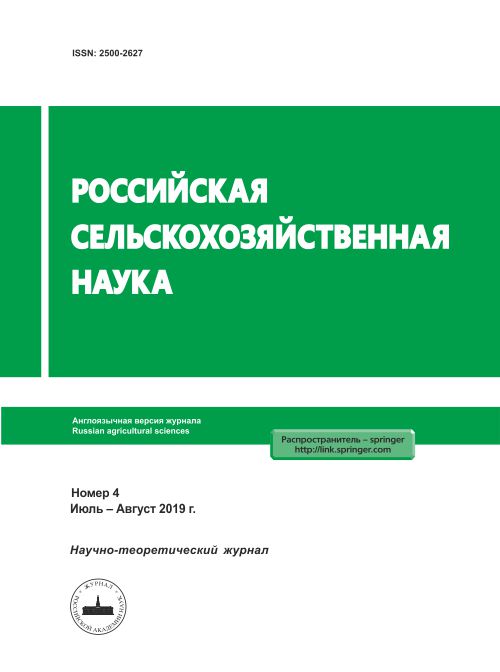To question about breeding naked oat Virovets
- Autores: Batalova G.A.1, Loskutov I.G.2, Shevchenko S.N.3, Zhuikova O.A.1, Krotova N.V.1, Tulyakova M.V.4
-
Afiliações:
- Federal Agricultural Scientific Center of North-East
- Federal Research Center N. I. Vavilov All-Russian Institute of Plant Genetic Resources
- Samara Agricultural Research Institute
- Falenskaya breeding station – branch of Federal Agricultural Scientific Center of North-East.
- Edição: Nº 4 (2019)
- Páginas: 8-11
- Seção: Plant growing
- URL: https://journals.eco-vector.com/2500-2627/article/view/15761
- DOI: https://doi.org/10.31857/S2500-2627201948-11
- ID: 15761
Citar
Texto integral
Resumo
The aim of the research was to develop a cultivar of naked oat with improved traits of productivity and grain quality for cultivation under climate change conditions and utilization in breeding practice as a source of useful economic properties. The pre-flag leaf’s area was found to render a considerable effect on the formation of the number of grains and grain weight in the panicle and on the total biomass (r= 0.78-0.85), while the area of leaves depended on the duration of the period from seedling emergence to wax ripeness (r = ‒0.79) and on agroclimatic conditions during the growing season (HTC, r = 0.76). The flag leaf’s pigments (Chl a, Chl b, Car) were observed to have a sizable effect on the weight of 1000 grains during the period from flowering to milk ripeness (r = 0.79-0.88). The new naked cultivar ‘Virovets’ (1h07) with improved levels of productivity and grain quality (1000 grain weight: 29.2 g; crude protein content: up to 19.8%; oil of the oleic-linoleic group: 7.71%, grain volume weight: 670 g/l; pubescence: weak) was developed to be cultivated for food and feed purposes and be used in naked oat breeding as a source of high grain quality.
Palavras-chave
Texto integral
Sobre autores
G. Batalova
Federal Agricultural Scientific Center of North-East
Autor responsável pela correspondência
Email: g.batalova@mail.ru
academician of RAS
Rússia, Kirov, ul. Lenina, 166АI. Loskutov
Federal Research Center N. I. Vavilov All-Russian Institute of Plant Genetic Resources
Email: i.loskutov@vir.nw.ru
Rússia, Sankt-Peterburg, ul. Bolshaya Morskaya, 44
S. Shevchenko
Samara Agricultural Research Institute
Email: samniish@mail.ru
corresponding member of the RAS
Rússia, Bezenchuk, Samarskaya oblast, ul. K. Marxa, 41O. Zhuikova
Federal Agricultural Scientific Center of North-East
Email: g.batalova@mail.ru
candidate of agricultural sciences
Rússia, Kirov, ul. Lenina, 166АN. Krotova
Federal Agricultural Scientific Center of North-East
Email: g.batalova@mail.ru
candidate of agricultural sciences
Rússia, Kirov, ul. Lenina, 166АM. Tulyakova
Falenskaya breeding station – branch of Federal Agricultural Scientific Center of North-East.
Email: fss-nauka@mail.ru
Rússia, s. Falenki, ul. Timiryazeva, 3
Bibliografia
- https://www.agroxxi.ru/analiz-rynka-selskohozjaistvennyh-tovarov/mirovoe-proizvodstvo-ovsa-lidery i autsaidery.html].
- https://smart-lab.ru/blog/495544.php
- www.prod.center/news/tag/2/23055-valovoi-sbor-ovsa
- Ahokas H., Heikkila E., Alho M. Variation in the ratio of oat (Avena) protein fractions of interest in celiac grain diets // Genetic Resource and Crop Evolution. – 2005. – V. 52. – P. 813–81.
- Rzedzicki Z., Blaszczak W. Impact of microstructure in modeling physical properties of cereal extrudates // International Agrophysics. – 2005. – V. 19. – P. 175–186.
- Peltonen-Sainio P., Kirkkari A.M., Jauhiainen L. Charactering strengths, weaknesses, opportunities and threats in producing naked oat as a novel crop for northern growing conditions // Agricultural and Food Science. – 2004. – V.13. – №1-2. – P. 212-228.
- Leonova, S., Shelenga, T., Hamberg, M., Konarev, A.V., Loskutov, I., Carlsson A.S. Analysis of oil composition in cultivars and wild species of oat (Avena sp.) // Journal of Agricultural and Food Chemistry. – 2008. – V. 56. –. P.7983-7991.
- Girardet N., Webster F.H. Oat milling: specifications, storage, and processing. In Oats: Chemistry and Technology, Processing of oats // British Journal of Nutrition. – 2011. – 2. – P. 301-316.
- Decker E.A., Rose D.J., Stewart D. Processing of oats and the impact of processing operations on nutrition and health benefits // British Journal of Nutrition. – 2014. – 112. – P. 58-64.
- Šubarić D., Babić J., Lalić A., Ačkar Đ., Kopjar M. Isolation and Characterisation of Starch from Different Barley and Oat Varieties // Czech Journal of Food Sciens (CJFC). – 2011. – V.29. – № 4. – P. 354 – 360.
- http://gossort.com/docs/REESTR_2018.pdf
- Лоскутов И.Г. Овес (Avena L.). Распространение, систематика, эволюция и селекционная ценность. – СПб.: ГНЦ РФ ВИР, 2007. – 336 с.
- Колмаков Ю.В. Объективность идентификации форм овса с высокими крупяными свойствами // Вестник Россельхозакадемии. – 2009. – № 6. – С. 56-58.
- Tekauz A.B., Fetch J.M., Rossnagel B.G., Savard M.E. Progress in assessing the impact of Fusarium head blight on oat in western Canada and screening of Avena germplasm for resistence // Cereal Res. Comm. – 2008. – 36. – 8. – P. 49-56.
- Гагкаева Т.Ю., Шамшев И.В., Гаврилова О.П., Селицкая О.Г. Биология взаимоотношений грибов рода Fusarium и насекомых (обзор) // Сельскохозяйственная биология. – 2014. – №3. – C. 13-23. doi: 10.15389/agrobiology.2014.3.13rus.
- Методика государственного сортоиспытания сельскохозяйственных культур, 1985. – 230 с.
- Методические указания по селекции ячменя и овса. – Киров: НИИСХ Северо-Востока, 2014. – 64 с.
- Пакуль В.Н., Мартынова С.В., Андросов Д.Е. Источники ярового ячменя по засухоустойчивости в условиях лесостепи Западной Сибири // Международный научно-исследовательский журнал. – 2016. – №2(44). – 3. – С. 102-106.
- Krasilnikov V.N., Batalova G.A., Popov V.S., Sergeeva S.S. Fatty Acid Composition of Lipids in Naked Oat Grain of Domestic Varieties // Russian Agricultural Sciences. – 2018. – V. 44. – No. 5. – Р. 406–408.
Arquivos suplementares









